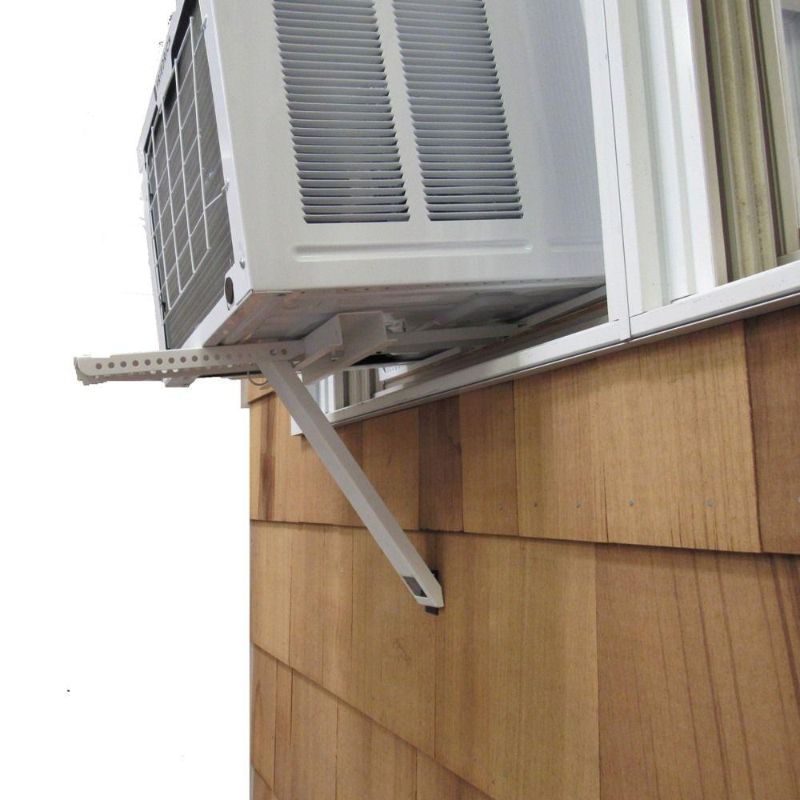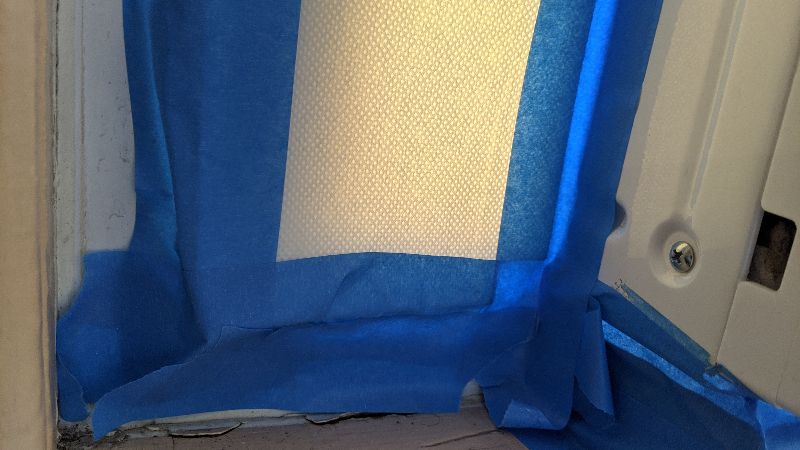How to Install a Window Air Conditioner in a Vinyl Replacement Window with Vinyl Siding
| . Posted in News - 7 Comments
Most window air conditioners are designed to fit in most windows. Vinyl windows, however, are usually not designed for the weight of window air conditioners. And if your building has vinyl siding, as well, it may crack when a “window air conditioner mount” is used.
Some rentals may have a heat pump installed that could also act as an air conditioner in the hottest months, or central air. But if you don't have those options available, you're going to need to figure out how to cool your rentals in the summer. The challenge is how to install an air conditioner without damaging your vinyl replacement windows, or your vinyl siding.
In this article, we'll cover how to ensure window a/c installation doesn’t damage your vinyl windows or siding. This article may be read by landlords looking to advise renters, or by renters looking to keep your full security deposit.
Renters take note: Talk to your landlord before attempting to install a window air conditioner.

This Pella 250 vinyl window has two air sealing lips, highlighted by sun and shadow. Some vinyl windows will have only one.
Danger: Improper procedure when installing a window air conditioner can result in immediate or subsequent injury or death. When in doubt, contact a professional.
The Problem with Vinyl Windows
Like wood and metal, vinyl windows can be sturdy and energy efficient. But unlike wood and metal, vinyl windows often achieve energy-efficiency with a lip that sticks up from the windowsill. This lip interrupts what would otherwise be a smooth transition between interior stool and exterior sill.
The lip supports one or more fuzzy baffles to stop air leaks. The first baffle position is at the bottom of the lower sash; a fuzzy strip presses against either the lip or the windowsill. The second baffle position is higher up on that lip; another fuzzy strip presses against the bottom front of the lower sash.
The lip is not designed to carry the weight of a window air conditioner. A window air conditioner placed on this lip can bend and crack the lip, or pop the corner welds of the window frame. Your window will then be open to insects in the summer and substantial heat loss next winter. This problem is not encountered on wood or metal frame windows, which either have strong metal lips, or a lip-free step-down between interior stool and exterior sill.
Before installing an air conditioner in a vinyl window, check that your rental agreement permits window air conditioners. It may be that only floor models are allowed.

Air conditioner window mounts like this one sold at Home Depot are typically shown against very hard exteriors, like wood shingle. It is too difficult to safely place such a mount on vinyl siding without cracking the siding.
The Problem with Vinyl Siding and Support Brackets
Window air conditioner support brackets are sold online. They are structurally better than the wood block method described below. A support bracket transfers the load of the air conditioner to the exterior of your building. But as often as not, they crack vinyl siding.
If you have vinyl siding, each course has one or more raised profile ridges. If you put the bracket’s weight against a raised profile ridge, the raised profile ridge will be flattened against the building. The siding will crack, if not immediately then over time. This will expose the building to rain and weather and create an eyesore, too.
If you could locate the bracket on the flat part of the siding profile, then you could transfer the load through the siding to the house without deforming the siding. It is possible to do this without cracking the siding. But it is very difficult to do this safely. The position you establish for the bracket unloaded will shift down when you load it with the air conditioner, sliding away from your set point and potentially cracking your siding. You either need an exterior spotter or a “mirror on a stick” inspection mirror, and you need to be watching carefully as the bracket is loaded.
Note that when support brackets are advertised, they are advertised on brick, cement, or wood clapboard exteriors. (It can be hard to tell the difference between wood clapboard and vinyl siding in online pictures.) The support brackets are not advertised for use on vinyl siding.
If you have a tough exterior material, like brick or wood, then you should purchase a support bracket and use that instead of the wood block method described here.

This floor model puts no pressure on a vinyl window or vinyl siding. It was not necessary to remove the screen. The duct has been wrapped in foil to increase efficiency. Much better than a window air conditioner!
Avoid Window Air Conditioners and Pick Floor Models
Rather than install a window air conditioner, consider a floor model. The floor model air conditioners with a vent hose put very little weight on vinyl frames. Their vent outlet fits between any frame baffle lips. Floor air conditioners should be the recommendation for any apartment with vinyl windows and vinyl siding. The floor models can now be just as effective, efficient, and easy to operate as a window air conditioner. And they don’t require you to remove and store a screen, as you will see.
One disadvantage of the floor models is they do not drain outside the way window air conditioners do. If you use a floor model air conditioner, you must pay attention to the condensation tank or bucket. You must empty it from time to time.
Another disadvantage of a floor model is, unless it has two hoses (rare in economy models), the air conditioner will create negative pressure. This requires you to open a window a crack in a room where you don’t want air conditioning. Otherwise you will draft air in from your kitchen and bathroom vents, or worse, the apartment next door, above, or below. Unless your vents are cleaned and your neighbors are healthy and odor-free, you don’t want to be drafting air from these sources.
The Key to Vinyl Window Air Conditioners: Weight Distribution
The key to protecting a vinyl window lip is to distribute the weight of the air conditioner around the lip, onto the interior stool and the exterior sill. Home Depot and Lowes both sell shims in the lumber section. You can stack shims to create just enough height to get over one or both lips. We will demonstrate the technique.
You will want to look at the bottom of your air conditioner before setting shims. Some air conditioners are designed with a certain window shape in mind, or with feet or other unevenness. The front of the air conditioner’s base may be higher or lower than the back. Proper shimming will leave the air conditioner slightly angled downward outside. This will permit rain and condensation to drain outside. You may need to shim at two levels depending on the design of your window air conditioner and window frame.
Step One: Slide or Remove the Screen
Your window air conditioner will need to stick out past the screen.
Danger: never lean out of a window. Only your arms can go out as needed to hold a screen or to hold the back of the air conditioner.
If your window has a half screen, push it up out of the way of the lower sash, and leave it.
If your window has a full-height screen, you will need to remove it entirely. It is held in place with two hidden leaf springs. Open both sashes toward the middle, reach around the sashes with two long arms or a friend, and each pull gently on both right corners of the full-height screen toward the left. If the full-height screen slides and stops hard, switch sides and pull in the other direction. When you have found the correct direction, the full-height screen will “smoosh” in the direction of motion and spring back when you let go. Pull more forcefully in this direction to compress the two springs. (Be gentle: the corner tabs get brittle and break over time.) The pulled side will come clear of the plastic channel. Push out a small distance and the full-height screen will come loose.
When the full-height screen is loose, change your grip to the center bar, rather than the corners. Hold on firmly as you navigate the full-height screen out of the channel on each side, out away from the house. When the full-height screen is free from the channel, bring it in between the lower sash and the windowsill at an angle. Do not drop the full-height screen outside. You will lose your security deposit or incur liability if you wreck the screen, crack a window below, and/or hurt someone. Store the full-height screen in a closet or other place away from pets, children, and traffic where it will not get damaged.

Before you remove the screen and risk letting bugs in, you can use scrap wood or shims to estimate how much height you need. Make sure the shims are above the lip, otherwise the lip will still be carrying the load of the air conditioner.
Step Two: Place the Shims
You can tape the shims into a block of the correct height using painter’s tape. You can also tape the block to the window itself. Painter’s tape is good enough to hold a piece of wood on a flat window all summer, with the weight of the air conditioner doing most of the work to hold it down.
Danger: Do not leave children unattended in a room with a lower window sash open. Even with a screen, a child can bounce off a bed or other piece of furniture and fall out the window. If you have a child and you need to leave the window to get tape, close and lock the window before leaving.
Step Three: Lift the Air Conditioner into the Vinyl Window, Check Fit
Before lifting, make sure the air conditioner works (plug it in). Make sure that the accordion baffles on either side are installed and will extend (keep them retracted for now).
With a friend, lift the air conditioner and place it – do not drop it – onto the shims. Always have one hand on the back outside part of the air conditioner to keep it from tipping. The air conditioner should sit without wobbling. If it wobbles, remove it, set it back on the floor, and place or remove shims. Or if you have a friend, one can adjust the shims while the other holds the air conditioner.
You may need additional shims on either side, the front, or the back, or on two heights of window frame. Keep your hand on the back of the air conditioner the whole time and into the next step.
Step Four: Lower the Sash
The air conditioner should be placed such that the bottom sash can be lowered onto the outside of the air conditioner. Window air conditioners are designed with a metal lip that presses against the sash from the inside to hold them in. Lower the sash while still holding the back of the air conditioner, with your arm outside the window. Your arm will be left sticking out the hole normally filled by the accordion baffle on either side.
If the window air conditioner is properly shimmed, and the sash is properly aligned, the air conditioner should be secure. Slowly release pressure on your outside grip. The air conditioner should remain seated still. If it moves to tip or settle sharply, raise the sash, remove the window air conditioner, and re-shim.

This apparently sloppy tape job is actually sealed against insects. It is double-taped: the underlying accordion baffles are taped very carefully, and then a piece of foam (shown here) is taped quickly over the baffles to increase energy efficiency. The underlying layer should be done carefully.
Step Five: Sealing a Vinyl Window Air Conditioner
When the air conditioner is seated stably and the lower sash has been lowered safely against it, let go of the air conditioner and pull your arm inside the building.
First extend the accordion baffles out from either side of the air conditioner. Do not drill them into the window unless you feel there is a security risk from outside or children on the inside who would tamper with the baffles; drilling can damage the window. The accordion baffles often stay in place with just friction and tape, without screws.
Secure the window. If the top sash has a pull-down lip, common in vinyl, you want a dowel custom cut to length or an extensible stop (sometimes called a window burglar bar or security bar). Put it between this top sash lip and the bottom sash. It should be impossible to open either sash. (Note that brackets and screws will be needed if you don’t have a top sash pull-down lip.)
Use a strip of foam to create an air barrier between the bottom sash and the top sash. Then use painter’s tape (low-residue) to seal all around the air conditioner and the foam. Make sure to seal very well for both efficiency and safety.
Danger: Massachusetts and other warm climates carry mosquito-borne illnesses like West Nile virus, eastern equine encephalitis, malaria, dengue, and yellow fever. Any hole is a potential vector for disease. Seal completely.
After the First Rain
After the first rain on your new air conditioner, look around the inside bottom and make sure nothing is wet. If you installed it correctly, any rain should have drained outside and there should be no water leakage around the inside.
Enjoy! And remember to keep your door and other windows closed to realize the full benefit of air conditioning in that room.
Window Air Conditioner Conclusion
Window air conditioners can damage vinyl windows and vinyl siding, so when possible, purchase a floor model and install that instead. If you must use a window air conditioner, check with your landlord to see if they have a particular way they want it installed. Otherwise make sure you distribute the load evenly across the frame using wood blocks or shims. If you don’t have both a vinyl window and vinyl siding, purchase a standard window air conditioner mount and use that instead of this wood block approach.
Suggestions for how to improve this article? Let us know at hello@masslandlords.net.




